Performance Characterization of Broad Band Sustainable Sound Absorbers Made of Almond Skins
Abstract
1. Introduction
2. Materials and Methods
2.1. Raw Materials
2.2. Sample Preparation
3. Methods
3.1. Physical Measurements
3.2. Thermal Measurements
3.3. Hygric Measurements
3.4. Acoustic Measurements
3.5. Non-Acoustic Measurements
4. Results and Discussion
4.1. Thermal and Hygric Characterization
4.2. Acoustic and Non-Acoustic Parameters
5. Conclusions
Author Contributions
Funding
Acknowledgments
Conflicts of Interest
Appendix A
References
- Pappu, A.; Mohini, S.; Asolekar, S.R. Solid wastes generation in India and their recycling potential in building materials. Build. Environ. 2007, 42, 2311–2320. [Google Scholar] [CrossRef]
- Rubino, C.; Bonet Aracil, M.; Liuzzi, S.; Stefanizzi, P.; Martellotta, F. Wool waste used as sustainable nonwoven for building applications. J. Clean. Prod. 2021, 278, 123905. [Google Scholar] [CrossRef]
- Mati-Baouche, N.; De Baynast, H.; Michaud, P.; Dupont, T.; Leclaire, P. Sound absorption properties of a sunflower composite made from crushed stem particles and from chitosan bio-binder. Appl. Acoust. 2016, 111, 179–187. [Google Scholar] [CrossRef]
- Liuzzi, S.; Rubino, C.; Martellotta, F.; Stefanizzi, P.; Casavola, C.; Pappalettera, G. Characterization of biomass-based materials for building applications: The case of straw and olive tree waste. J. Ind. Crop. Pro. 2020, 147, 11222. [Google Scholar] [CrossRef]
- Madurwar, M.V.; Ralegaonkar, R.V.; Sachin, A.M. Application of agro-waste for sustainable construction materials: A review. Constr. Build. Mater. 2013, 38, 872–878. [Google Scholar] [CrossRef]
- Available online: http://www.fao.org/home/en/ (accessed on 20 October 2020).
- Sottile, F.; Massaglia, S.; Peano, C. Ecological and Economic Indicators for the Evaluation of Almond (Prunus dulcis L.) Orchard Renewal in Sicily. Agriculture 2020, 10, 301. [Google Scholar]
- Liu, L.F.; Li, H.Q.; Lazzaretto, A.; Manente, G.; Tong, C.Y.; Liud, Q.B.; Ping, L.N. The development history and prospects of biomass-based insulation materials for buildings. Renew. Sustain. Energy Rev. 2017, 69, 912–932. [Google Scholar] [CrossRef]
- Da Silva, A.R.; Mareze, P.; Brandão, E. Prediction of sound absorption in rigid porous 348 media with the lattice Boltzmann method. J. Phys. A Math. Theor. 2016, 49, 6. [Google Scholar]
- De Carvalho, P.S.; Macklini, D.N.; Cantorski da Rosa, L. Development of an acoustic absorbing material based on sunflower residue following the cleaner production techniques. J. Clean. Prod. 2020, 270, 122478. [Google Scholar] [CrossRef]
- Fouladi, M.H.; Nassir, M.H.; Ghassem, M.; Shamel, M.; Yeng Peng, S.; Wen, S.Y.; Xin, P.Z.; Nor Mohd, M.J. Utilizing Malaysian natural fibers as sound absorber. In Modeling and Measurement. Methods for Acoustic Waves and for Acoustic Microdevices; Beghi, M.G., Ed.; IntechOpen Limited: London, UK, 2013; pp. 161–170. ISBN 978-953-51-1189-4. [Google Scholar]
- Martellotta, F.; Cannavale, A.; De Matteis, V.; Ayr, U. Sustainable sound absorbers obtained from olive pruning wastes and chitosan binder. Appl. Acoust. 2018, 141, 71–78. [Google Scholar] [CrossRef]
- Asdrubali, F.; Schiavoni, S.; Horoshenkov, K.V. A review of sustainable materials for acoustic applications. Build. Acoust. 2012, 19, 283–312. [Google Scholar] [CrossRef]
- Kaynakli, O. A review of the economical and optimum thermal insulation thickness for building applications. Renew. Sust. Energ. Rev. 2012, 16, 415–425. [Google Scholar] [CrossRef]
- Al-Homoud, M.S. Performance characteristics and practical applications of common building thermal insulation materials. Build. Environ. 2005, 40, 353–366. [Google Scholar] [CrossRef]
- Korjenic, A.; Petránek, V.; Zach, J.; Hroudová, J. Development and performance evaluation of natural thermal-insulation materials composed of renewable resources. Energ. Buildings 2011, 43, 2518–2523. [Google Scholar] [CrossRef]
- Luamkanchanaphana, T.; Chotikaprakhan, S.; Jarusombati, S. A Study of Physical, Mechanical and Thermal Properties for Thermal Insulation from Narrow-leaved Cattail Fibers. APCBEE Procedia 2012, 1, 46–52. [Google Scholar] [CrossRef]
- Özcan, M.M.; Ünver, A.; Erkan, E.; Arslan, D. Characteristics of some almond kernel and oils. Sci. Hortic. 2011, 127, 330–333. [Google Scholar]
- Prgomet, I.; Berta Gonçalves, P.; Perles, R.D.; Seva, N.P.; Barros, A.I. Valorization Challenges to Almond Residues: Phytochemical Composition and Functional Application. Molecules 2017, 22, 1774. [Google Scholar] [CrossRef]
- Sanjay, M.R.; Madhu, P.; Jawaid, M.; Senthamaraikannan, P.; Senthil, S.; Pradeep, S. Characterization and properties of natural fiber polymer composites: A comprehensive review. J. Cleaner Prod. 2018, 172, 566–581. [Google Scholar] [CrossRef]
- Kumar, S.; Singh, R.; Singh, T.P.; Batish, A. PLA composite matrix as functional prototypes for four dimensional applications. In Reference Module in Materials Science and Materials Engineering, 2nd ed.; Elsevier: Amsterdam, The Netherlands, 2019; pp. 1–12. ISBN 978-0-12-803581-8. [Google Scholar]
- García, A.V.; Santonja, M.R.; Sanahuja, A.B.; Garrigós, C. Characterization and degradation characteristics of poly (e -caprolactone) -based composites reinforced with almond skin residues. Polym. Degrad. Stab. 2014, 108, 269–279. [Google Scholar] [CrossRef]
- Mankotia, K.; Shing, I.; Shing, R. On effect of almond skin powder waste reinforcement in PA6: Rheological, thermal and wear properties. Mater. Today Proc. 2020, 33, 1546–1551. [Google Scholar] [CrossRef]
- Müller, B.; Rath, W. Formulierung von Kleb- und Dichtstoffen: Das kompetente Lehrbuch für Studium und Praxis; Vincentz Network GmbH & Co KG: Hannover, Germany, 2004; ISBN 978-3866306059. [Google Scholar]
- Heinrich, L.A. Future opportunities for bio-based adhesives—advantages beyond renewability (Critical Review). Green Chem. 2019, 21, 1866–1888. [Google Scholar] [CrossRef]
- Formaldehyde Emission. Standards for Composite Wood Products; US Government, Environmental Protection Agency (EPA): Washington, DC, USA, 2017; pp. 89674–89743. Doc. Number 2016−2798.
- Mancini, E.; Antonelli, M.G.; Zobel Beomonte, P.; Sasso, M. Characterization and analytical parametrization of composite in cellulose fibre and PVA matrix. Compos. Part B Eng. 2019, 172, 496–505. [Google Scholar] [CrossRef]
- Ors, Y.; Atar, M.; Ozçïfçï, A. Bonding strength of poly(vinyl acetate)-based adhesives in some woods materials treated with impregnation. J. Appl. Polym. Sci. 2000, 76, 1472–1479. [Google Scholar] [CrossRef]
- Khan, U.; May, P.; Porwal, H. Coleman J. Improved adhesive strength and toughness of Polyvinyl Acetate Glue on addition of small quantities of graphene. ACS Appl. Mater. Interfaces 2013, 5, 1423–1428. [Google Scholar] [CrossRef] [PubMed]
- Parija, S.; Misra, M.; Mohanty, A.K. Studies of natural gum adhesive extracts: An overview. J. Macromol. Sci., Part C Polym. Rev. 2001, 41, 175–197. [Google Scholar] [CrossRef]
- Meer, W. Gum Arabic. Chapter 8. In Handbook of Water Soluble Gums and Resins; Davidson, R.L., Ed.; McGraw Hill: New York, NY, USA, 1980; ISBN 978-0070154711. [Google Scholar]
- Rubino, C.; Bonet Aracil, M.; Payá, J.G.; Liuzzi, S.; Stefanizzi, P.; Zamorano Cantó, M.; Martellotta, F. Composite eco-friendly sound absorbing materials made of recycled textile waste and biopolymers. Materials 2019, 12, 4020. [Google Scholar] [CrossRef] [PubMed]
- ISO 12570: 2000. Hygrothermal Performance of Building Materials and Products—Determination of Moisture Content by Drying at Elevated Temperature; International Organization for Standards: Geneva, Switzerland, 2000.
- ASTM D4892-14: 2019. Standard Test Method for Density of Solid Pitch (Helium Pycnometer Method); ASTM Internationa: West Conshohocken, PA, USA, 2019.
- Bouguerra, A.; Aït-Mokhtar, A.; Amiri, O.; Diop, M.B. Measurement of thermal conductivity, thermal diffusivity and heat capacity of highly porous building materials using transient plane source technique. Int. Commun. Heat Mass 2001, 28, 1065–1078. [Google Scholar] [CrossRef]
- ISO 12572: 2016. Hygrothermal Performance of Building Materials and Products—Determination of Water Vapour Transmission Properties—Cup Method; International Organization for Standards: Geneva, Switzerland, 2016.
- ISO 10534-2: 1998. Acoustics—Determination of Sound Absorption Coefficient and Impedance in Impedance Tubes—Part 2: Transfer-function method; International Organization for Standards: Geneva, Switzerland, 1998.
- Delany, M.E.; Bazley, E.N. Acoustical properties of fibrous absorbent materials. Appl. Acoust. 1970, 3, 105–116. [Google Scholar] [CrossRef]
- Miki, Y. Acoustical properties of porous materials—Generalizations of empirical models. J. Acoust. Soc. Jpn. 1990, 11, 19–24. [Google Scholar] [CrossRef]
- Attenborough, K. Acoustical characteristics of porous materials. Phys. Rep. 1982, 82, 179–227. [Google Scholar] [CrossRef]
- Attenborough, K. Acoustical characteristics of rigid fibrous absorbents and granular materials. J. Acoust. Soc. Am. 1983, 73, 785–799. [Google Scholar] [CrossRef]
- Johnson, D.L.; Koplik, J.; Dashen, R. Theory of dynamic permeability and tortuosity in fluid-saturated porous media. J. Fluid Mech. 1987, 176, 379–402. [Google Scholar] [CrossRef]
- Allard, J.F.; Champoux, Y. New empirical equation for sound propagation in rigid frame fibrous material. J. Acoust. Soc. Am. 1992, 91, 3346–3353. [Google Scholar] [CrossRef]
- Lafarge, D.; Lemarinier, P.; Allard, J.F.; Tarnow, V. Dynamic compressibility of air in porous structures at audible frequencies. J. Acoust. Soc. Am. 1997, 102, 1995–2006. [Google Scholar] [CrossRef]
- Pride, S.R.; Gangi, A.F.; Morgan, F.D. Deriving the equations of motion for porous isotropic media. J. Acoust. Soc. Am. 1992, 92, 3278–3290. [Google Scholar] [CrossRef]
- Allard, J.F.; Atalla, N. Propagation of Sound in Porous Media: Modelling Sound Absorbing Materials, 2nd ed.; John Wiley & Sons, Ltd.: Chichester, West Sussex, UK, 2009. [Google Scholar]
- Ingard, U.K.; Dear, T.A. Measurement of acoustic flow resistance. J. Sound Vib. 1985, 103, 567–572. [Google Scholar] [CrossRef]
- Atalla, N.; Panneton, R. Inverse acoustical characterization of open cell porous media using impedance tube measurements. Can. Acoust. 2005, 33, 11–24. [Google Scholar]
- JCGM 100:2008. Evaluation of Measurement Data—Guide to the Expression of Uncertainty in Measurement; International Bureau of Weights and Measures (BIPM): Saint-Cloud, France, 2008; Available online: https://www.bipm.org/en/publications/guides/gum.html (accessed on 20 October 2020).
- Rode, C.; Peuhkuri, R.; Hansen, K.K.; Time, B.; Svennberg, K.; Arfvidsson, J.; Ojanen, T. NORDTEST project on moisture buffer value of materials. In Proceedings of the AIVC 26th conference: Ventilation in Relation to the Energy Performance of Buildings. Air Infiltration and Ventilation, Brussels, Belgium, 21–23 September 2005; INIVE EEIG: Brussels, Belgium, 2005; pp. 47–52. [Google Scholar]
- Muthurajab, R.; Lacoste, C.; Lacroix, P.; Bergeret, A. Sustainable thermal insulation biocomposites from rice husk, wheat husk, wood fibers and textile waste fibers: Elaboration and performances evaluation. Ind. Crops Prod. 2019, 135, 238–245. [Google Scholar] [CrossRef]
- Binici, H.; Aksogan, O. Eco-friendly insulation material production with waste olive seeds, ground pvc and wood chips. J. Build. Eng. 2016, 5, 260–266. [Google Scholar] [CrossRef]
- Pinto, J.; Cruz, D.; Paiva, A.; Pereira, S.; Tavares, P.; Fernandes, L.; Varum, H. Characterization of corncob as a possible raw building material. Constr. Build. Mater. 2012, 34, 28–33. [Google Scholar] [CrossRef]
- Agoudjila, B.; Benchabane, A.; Boudennec, A.; Ibos, L.; Fois, M. Renewable materials to reduce building heat loss: Characterization of date palm wood. Energy Build. 2011, 43, 491–497. [Google Scholar] [CrossRef]
- Nguyen, D.M.; Grillet, A.C.; Diep, T.M.H.; Bui, Q.B.; Woloszyn, M. Characterization of hygrothermal insulating biomaterials modified by inorganic adsorbents. Heat Mass Transf. 2020, 56, 2473–2485. [Google Scholar] [CrossRef]
- Umnova, O.; Attenborough, K.; Shin, H.-C.; Cummings, A. Deduction of tortuosity and porosity from acoustic reflection and transmission measurements on thick samples of rigid-porous materials. Appl. Acoust. 2005, 66, 607–624. [Google Scholar] [CrossRef]
- Glé, P.; Gourdon, E.; Arnaud, L. Acoustical properties of materials made of vegetable particles with several scales of porosity. Appl. Acoust. 2011, 72, 249–259. [Google Scholar] [CrossRef]
- Sarradj, E.; Lerch, T.; Hubelt, J. Input parameters for the prediction of acoustical properties of open porous asphalt. Acta Acust. United Ac. 2006, 92, 86–96. [Google Scholar]
- Ghanbarian, B.; Hunt, A.G.; Ewing, R.P.; Sahimi, M. Tortuosity in porous media: A critical review. Soil Sci. Soc. Am. J. 2013, 7, 1461–1477. [Google Scholar] [CrossRef]
- Turo, D.; Umnova, O. Time Domain Modelling of Sound Propagation in Porous Media and the Role of Shape Factors. Acta Acust. United Ac. 2010, 96, 225–238. [Google Scholar] [CrossRef]
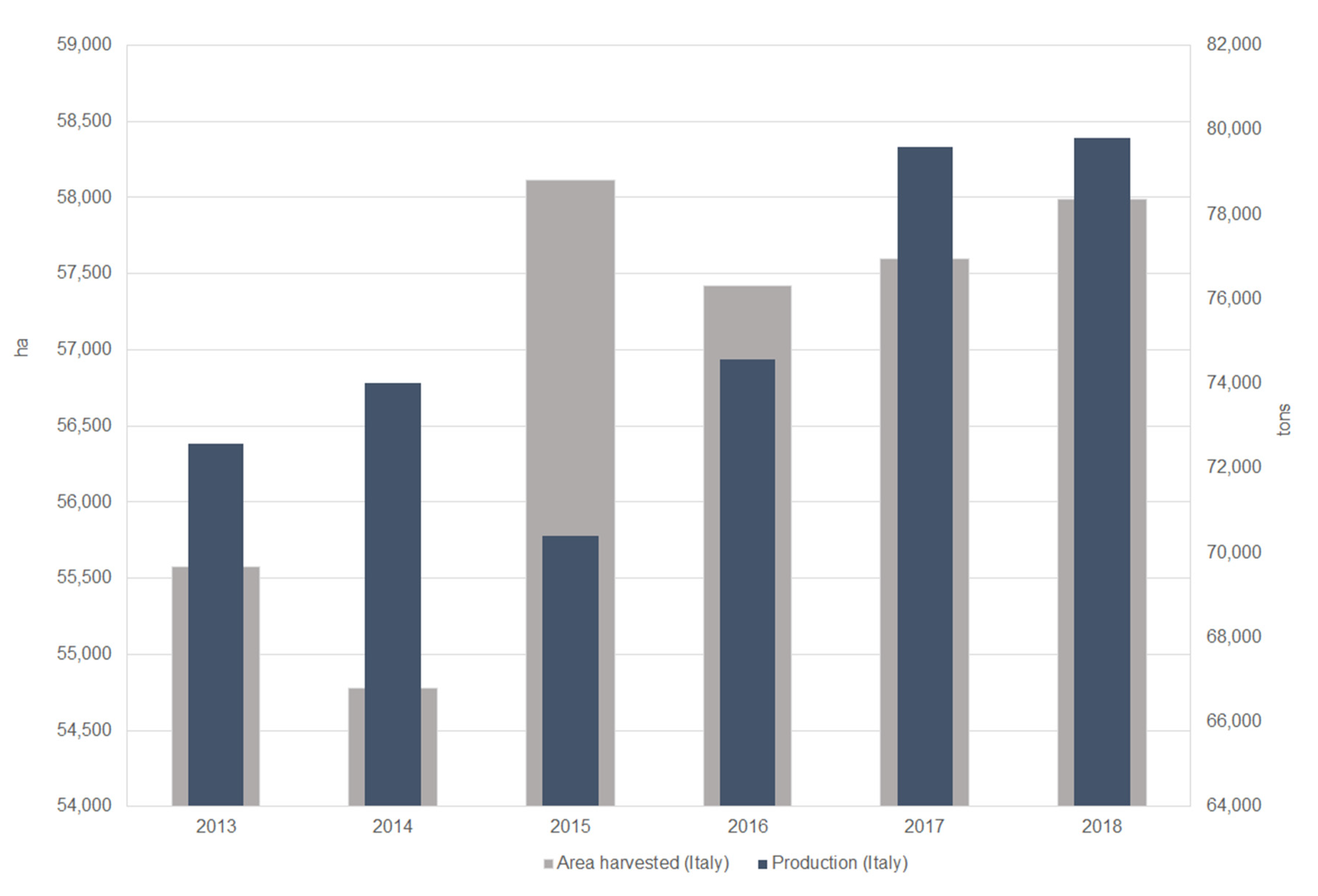

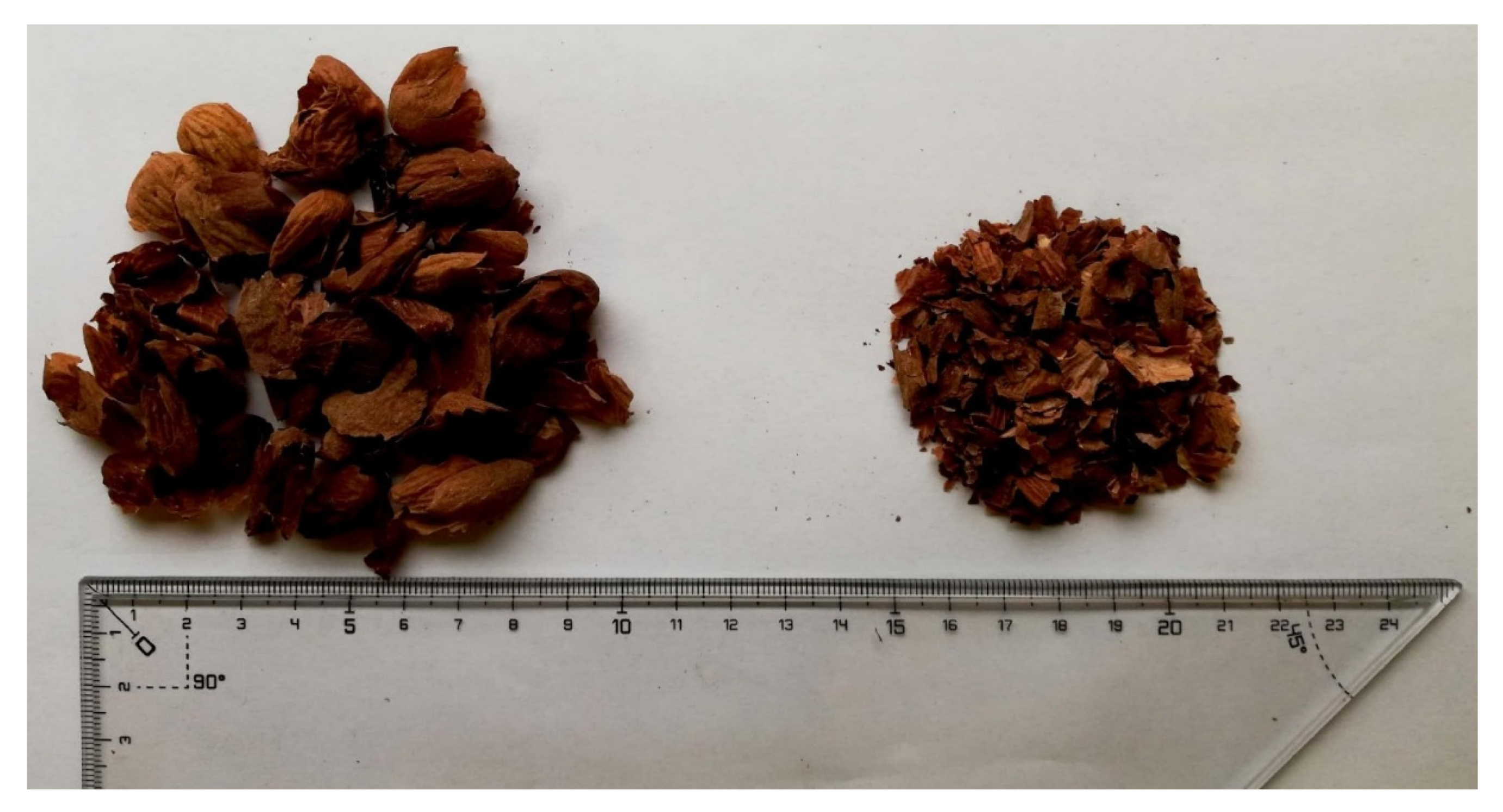
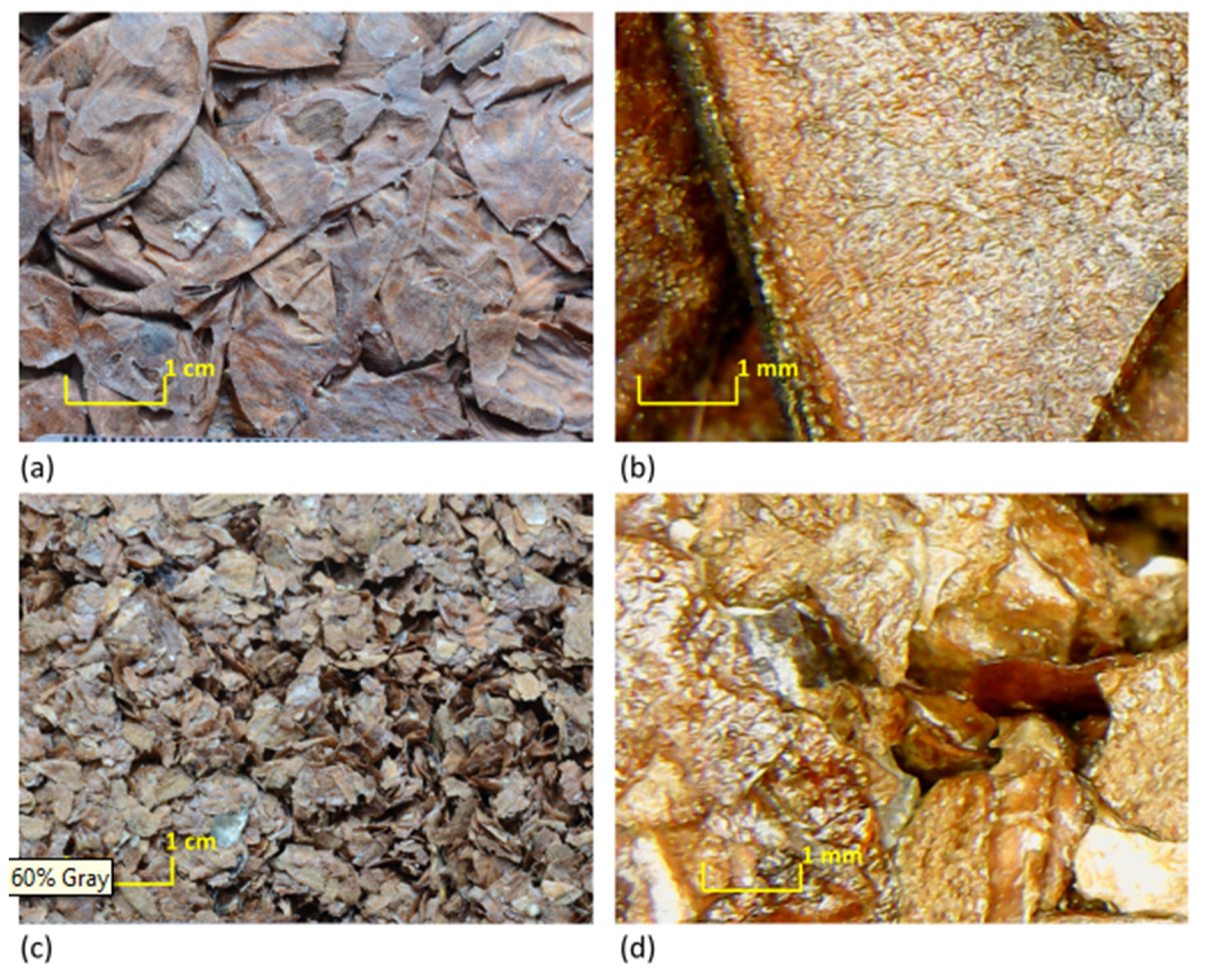
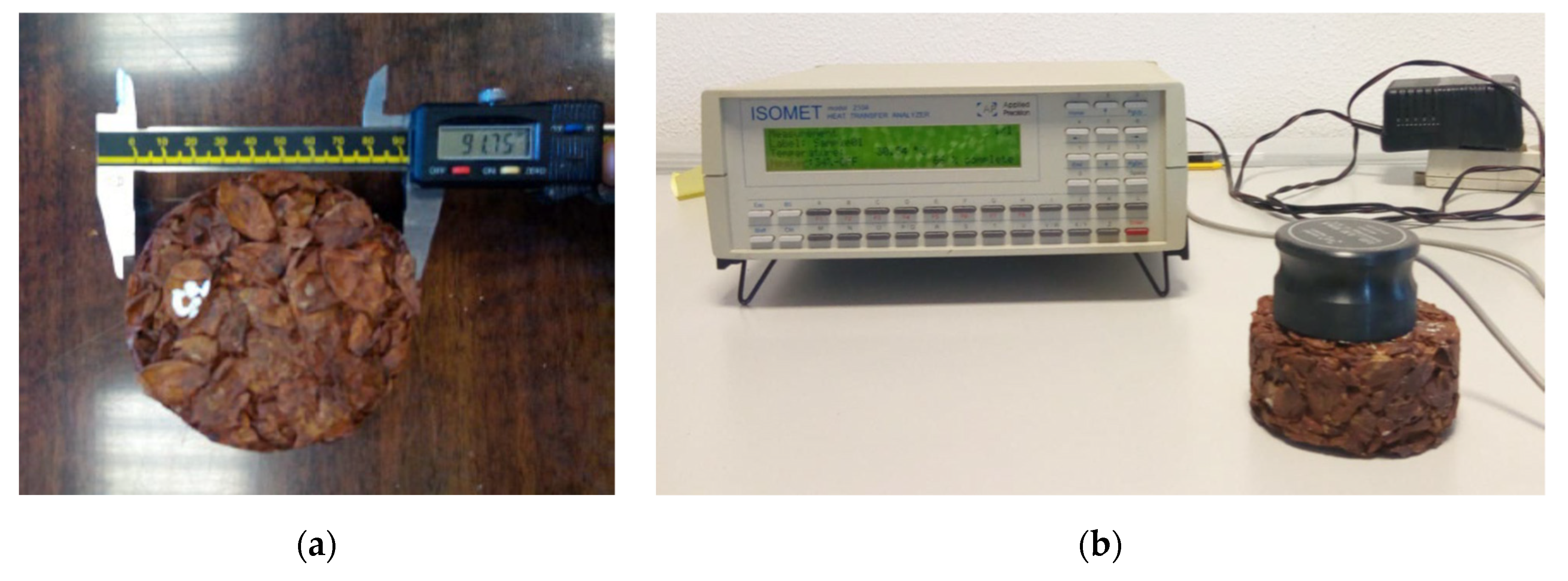
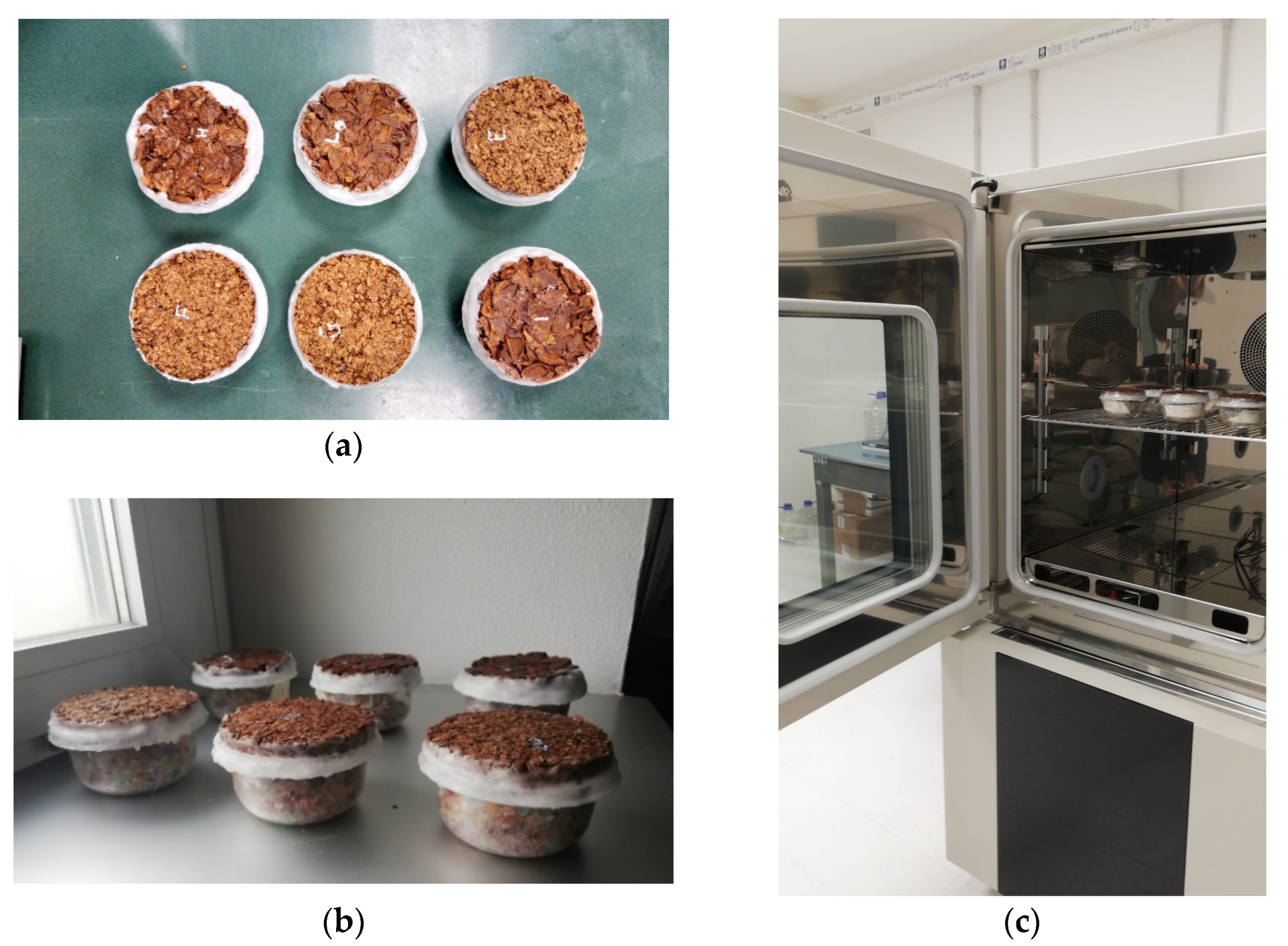
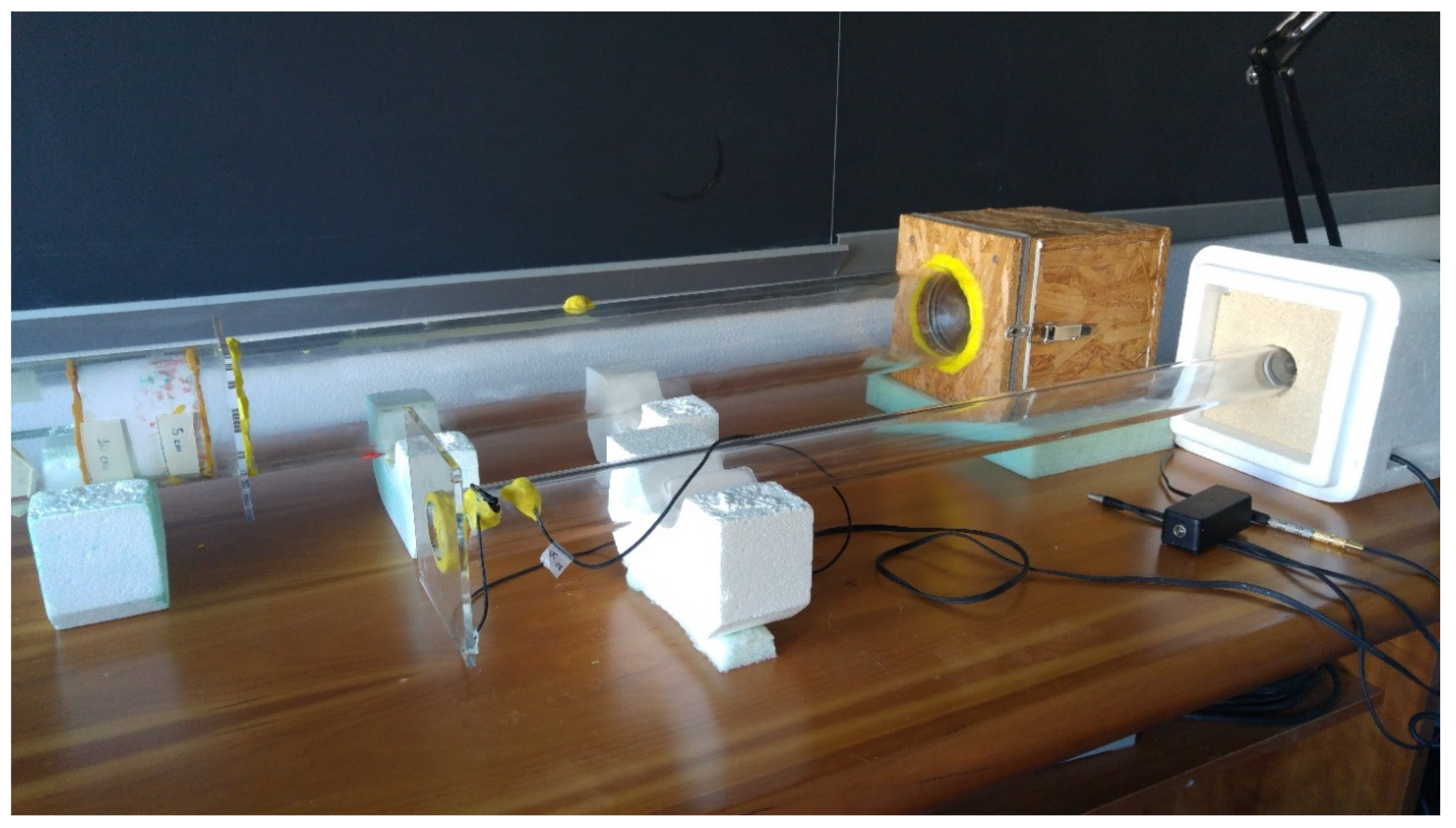
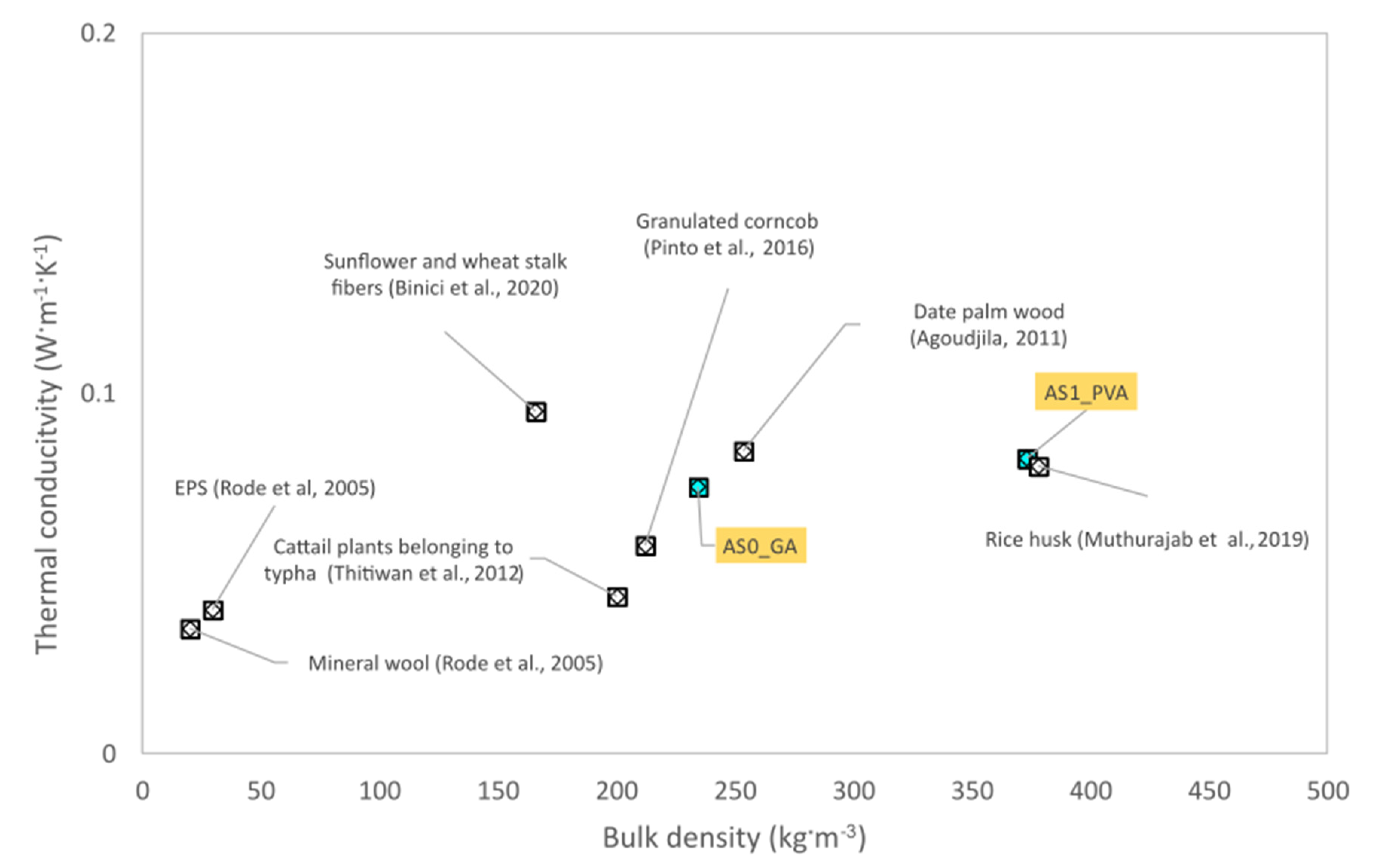
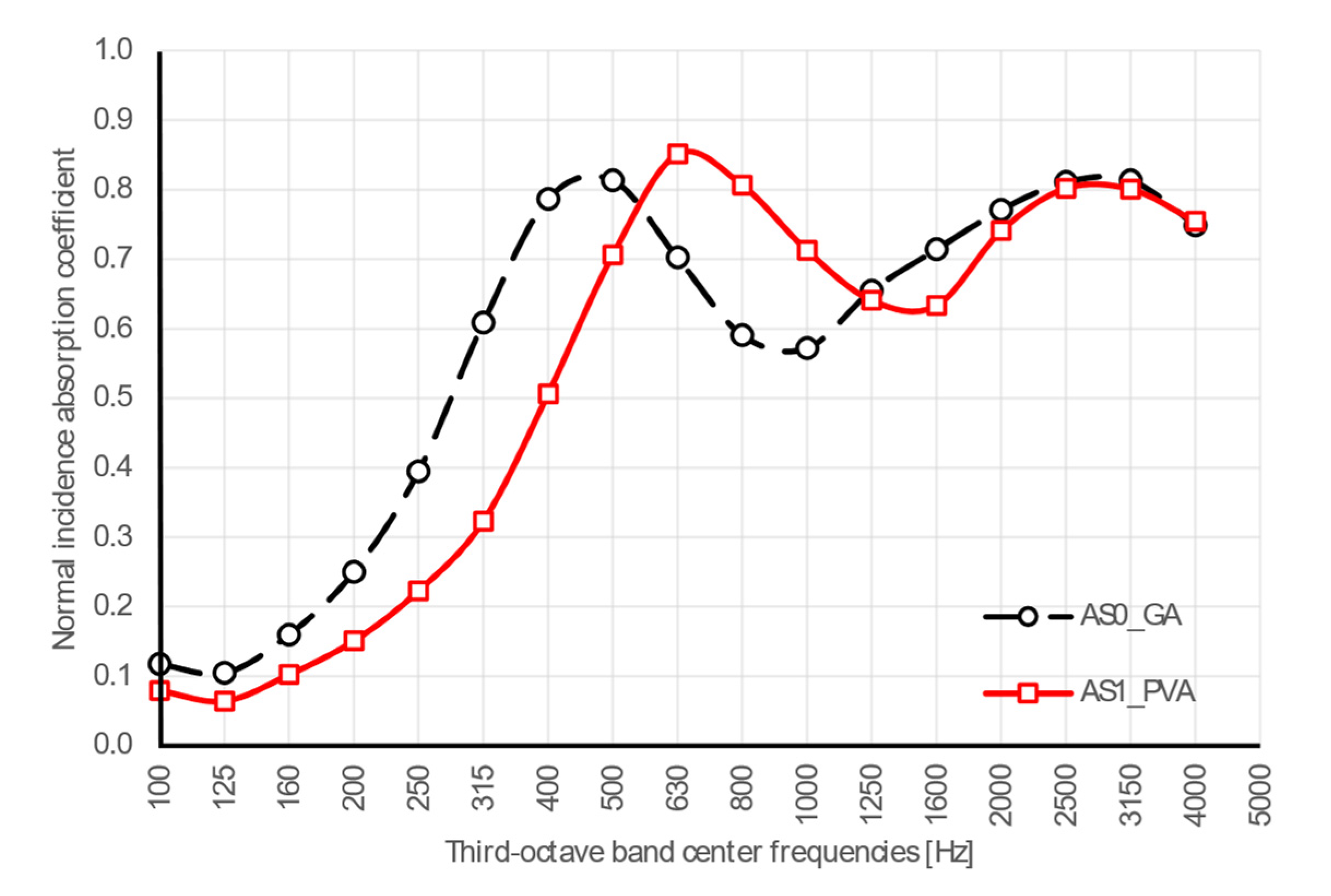

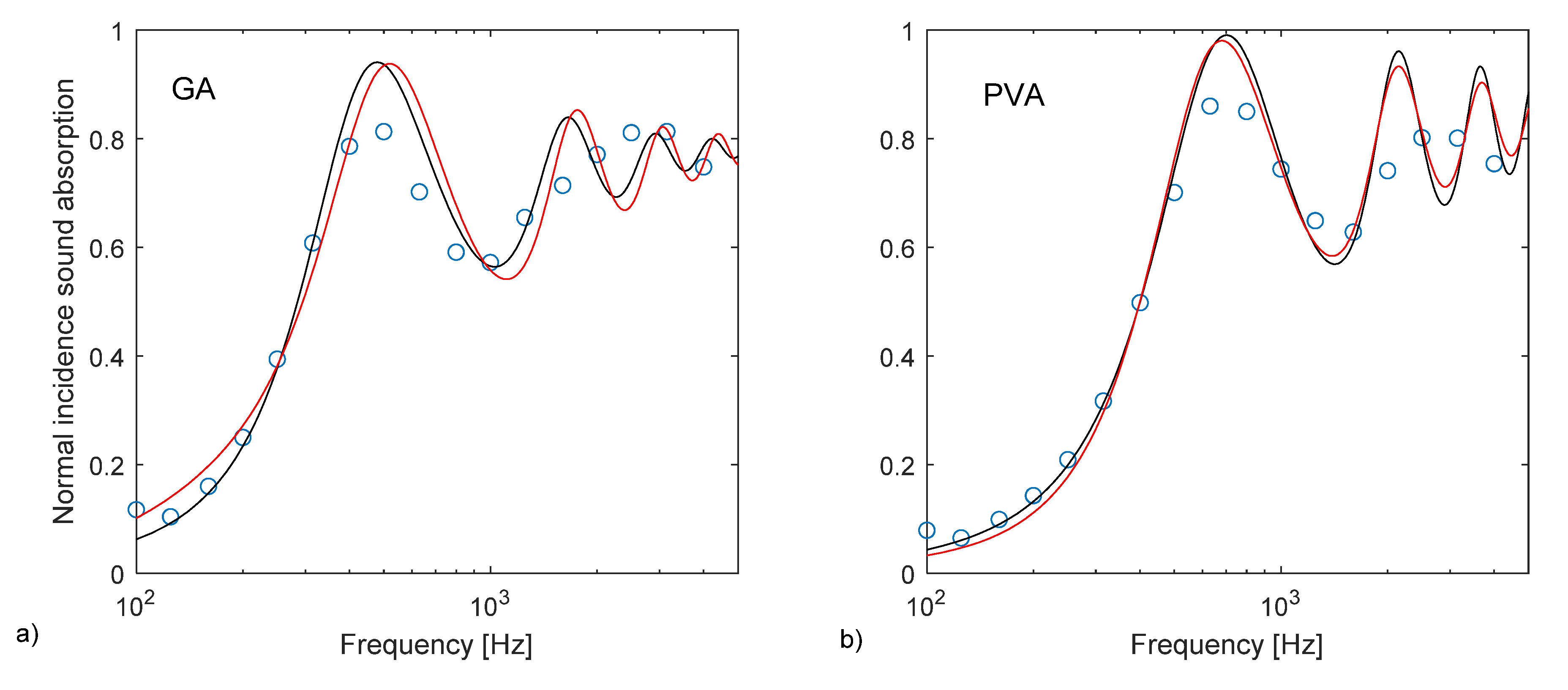
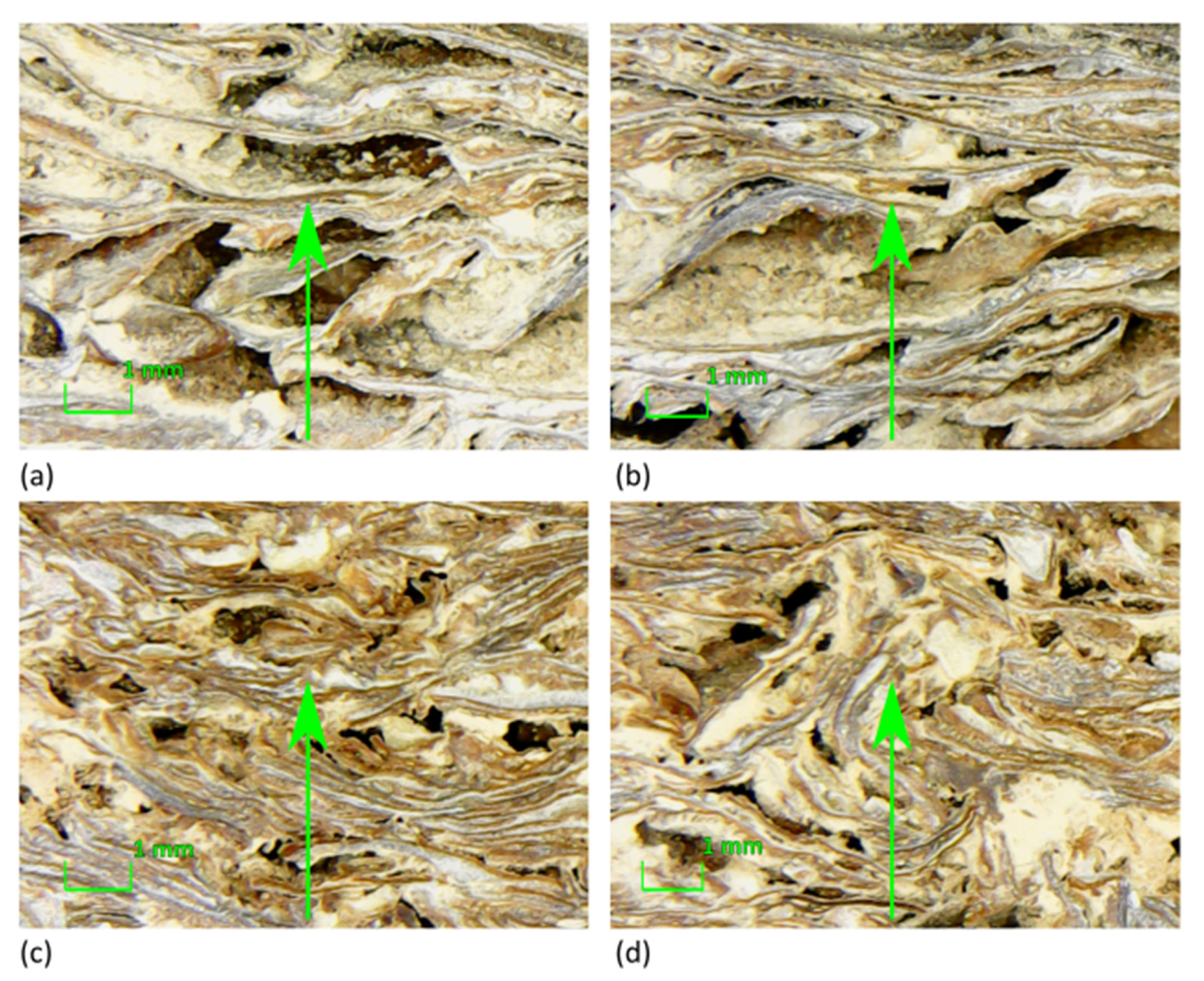
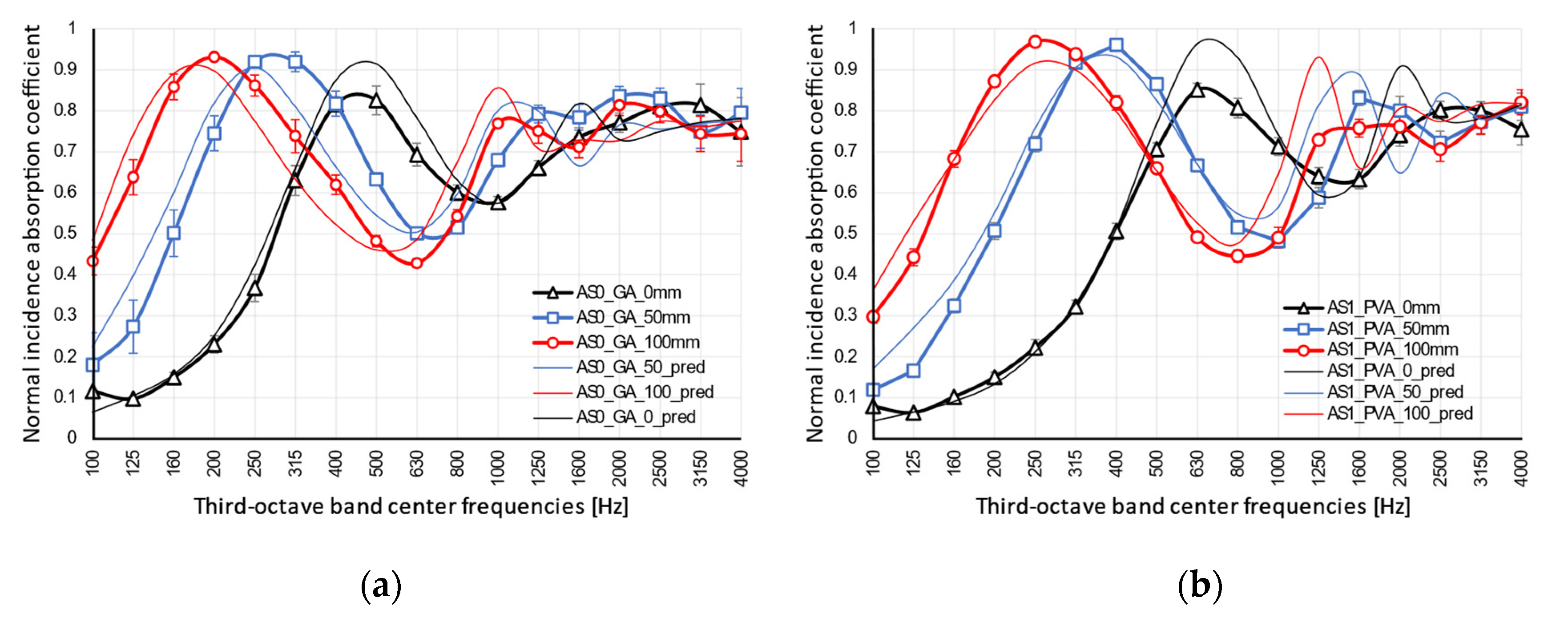
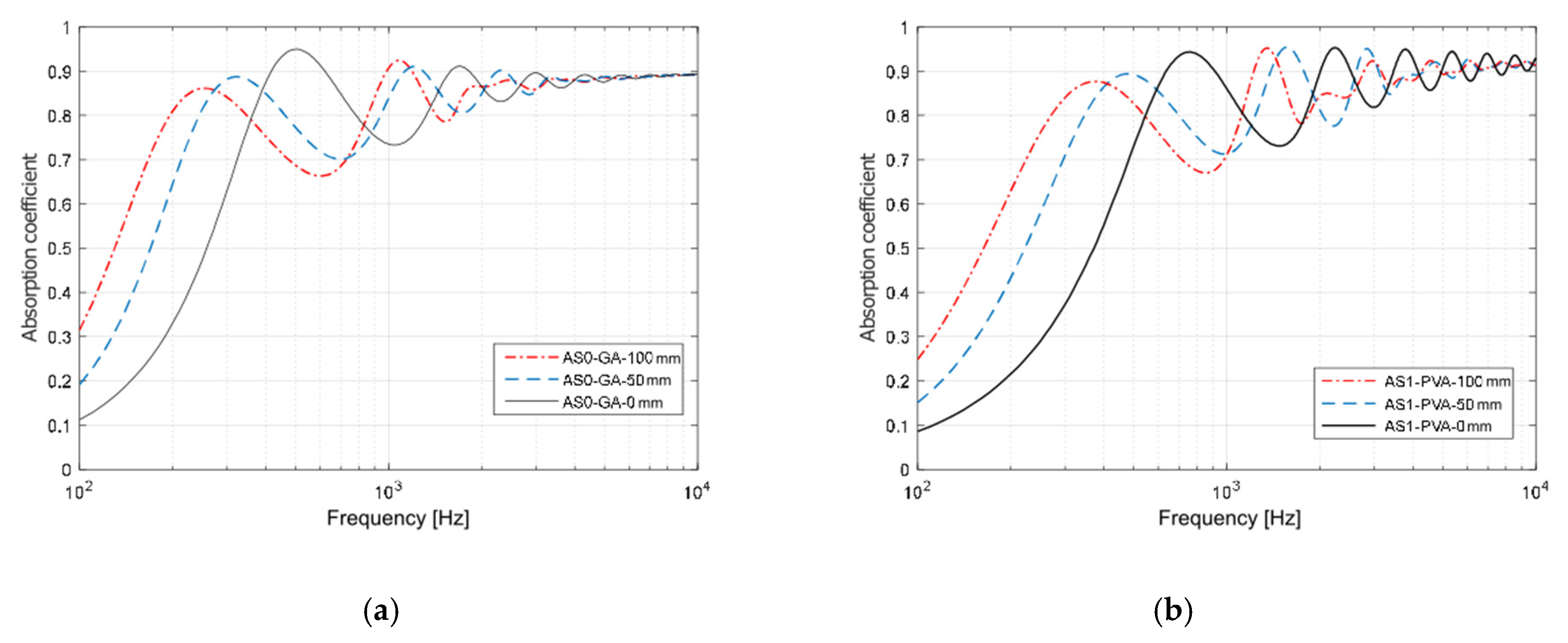
| Solution | Almond Skin (A) (g) | Gum Arabic (B) (g) | Polyvinyl Acetate (B) (g) | Water (g) | B/A Ratio |
|---|---|---|---|---|---|
| AS0_GA | 480 | 150 | - | 750 | 0.30 |
| AS1_PVA | 480 | - | 300 | 160 | 0.62 |
| Mix Code | Bulk Density | True Density | Thermal Conductivity | Thermal Diffusivity | Volumetric Heat Capacity | Water Vapor Resistance |
|---|---|---|---|---|---|---|
| ρb | ρt | λ | α | ρc | µ | |
| (kg·m−3) | (kg·m−3) | (W·m−1·K−1) | (10−6 m2·s−1) | (106 J·m−3·K−1) | (-) | |
| AS0_GA | 234.65 (13.99) | 1255.29 (19.88) | 0.074 (0.0035) | 0.180 (0.0276) | 0.416 (0.0533) | 13.0 (0.2) |
| AS1_PVA | 373.10 (6.20) | 1162.58 (7.29) | 0.082 (0.0080) | 0.219 (0.0342) | 0.384 (0.0745) | 14.9 (1.4) |
| Sample Code | Model | Bulk Porosity ɛ | Air-flow Resistivity σ | Tortuosity | Shape Factor | Ratio of Characteristic Dimensions | Static Thermal Permeability |
|---|---|---|---|---|---|---|---|
| (-) | (kN·s·m−4) | (-) | (-) | (-) | (m2) | ||
| AS0_GA | JCA | 0.81 (0.003) | 13.377 (1.164) | 5.50 | 3.00 | 1.50 | |
| JCAL | 5.40 | 3.00 | 2.00 | 3.1 × 10−9 | |||
| AS1_PVA | JCA | 0.68 (0.002) | 23.371 (1.791) | 4.40 | 1.36 | 1.95 | |
| JCAL | 5.00 | 2.36 | 1.80 | 2.1 × 10−9 |
Publisher’s Note: MDPI stays neutral with regard to jurisdictional claims in published maps and institutional affiliations. |
© 2020 by the authors. Licensee MDPI, Basel, Switzerland. This article is an open access article distributed under the terms and conditions of the Creative Commons Attribution (CC BY) license (http://creativecommons.org/licenses/by/4.0/).
Share and Cite
Liuzzi, S.; Rubino, C.; Stefanizzi, P.; Martellotta, F. Performance Characterization of Broad Band Sustainable Sound Absorbers Made of Almond Skins. Materials 2020, 13, 5474. https://doi.org/10.3390/ma13235474
Liuzzi S, Rubino C, Stefanizzi P, Martellotta F. Performance Characterization of Broad Band Sustainable Sound Absorbers Made of Almond Skins. Materials. 2020; 13(23):5474. https://doi.org/10.3390/ma13235474
Chicago/Turabian StyleLiuzzi, Stefania, Chiara Rubino, Pietro Stefanizzi, and Francesco Martellotta. 2020. "Performance Characterization of Broad Band Sustainable Sound Absorbers Made of Almond Skins" Materials 13, no. 23: 5474. https://doi.org/10.3390/ma13235474
APA StyleLiuzzi, S., Rubino, C., Stefanizzi, P., & Martellotta, F. (2020). Performance Characterization of Broad Band Sustainable Sound Absorbers Made of Almond Skins. Materials, 13(23), 5474. https://doi.org/10.3390/ma13235474








